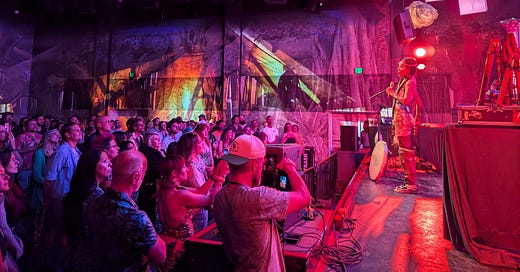What I Saw, Felt, and Learned at the Psychedelic Science Conference 2025
I showed up with no expectations.
That might sound cliché, but it’s true. I didn’t come with an agenda, a pitch deck, or even a plan. I just showed up in Denver with curiosity—and left with a notebook full of questions, awe, frustration, and a real sense of where this psychedelic movement is headed (and how messy that path can be).
Tuesday: Into the Dome
The trip started fast. Hours after landing, I helped set up an event hosted by One Heart for Snow Raven, a shamanic artist whose live performance took over a geodesic dome. It was part concert, part ritual, part tech-art spectacle. Her sounds—primal, looped, layered—morphed into visuals powered by a system from Reality Center.
The visuals? Unreal. Imagine an immersive projection synced in real-time with her voice and movements—animal calls turned into living light. The artist behind them was Adrien Oneiga, and his work made the dome feel like a living organism. Sound, spirit, light—all locked in.
And while I was there representing One Heart, what struck me most was the number of people—at a psychedelic convention—who’d never done ayahuasca. Everyone knew about it, but few had actually sat with the medicine. Most attendees were therapists, researchers, clinicians. This wasn’t the psychonaut crowd—it was the professionalized face of psychedelics.
Wednesday: Science, Vendors, and Microdoses
The convention itself? A mixed bag. No mind-blowing breakthroughs for me. A lot of the talks felt geared toward institutional validation—FDA, clinics, protocols, safety. Important work, no doubt. But not soul-stirring.
What did stir me: the vendor floor. New tools. Wild products. People giving out samples labeled "heart" and "magic" (yes, that’s MDMA and mushrooms). Tech like light and vibration beds that simulate psychedelic states. And again—Reality Center's gear stood out.
That night, I went to a Microdose Collective event—think: thought leaders like Paul from Third Wave, community builders, a mycelial network of humans working toward collective change. Ended up at an unofficial after-party. Music. Dancing. Gift bags with mushrooms. Welcome to the future.
Thursday: Indigenous Voices and Meow Wolf Madness
Thursday hit different. I leaned into the Indigenous panels—and they hit hard. There was pride, for sure. Gratitude. But also grief. Rage. Their message was crystal clear: they’re being pushed out—by loggers, by extractive economies, and now, by a psychedelic industry that too often forgets where these medicines came from.
This wasn’t performance. It was plea. A warning. Maybe the most important thing said all week.
Later, I went to a panel on psychedelics and fatherhood. Nothing stuck—but it planted a seed. It might be something I revisit, explore, maybe even write more about.
And then came Meow Wolf.
If you’ve never been, imagine a massive surrealist art playground fused with a music festival. DJs. Installations. Secret rooms. Rick Doblin showed up. So did Snow Raven again. Everyone who’s someone in psychedelics was there. It felt like the “main party” of the week. And it delivered.
We ended the night in the Meow Wolf parking lot—my friend set up his van with a sound system. A tiny renegade party until 5 a.m. It was beautiful. Raw. Real connection. Something the official schedule can’t capture.
Friday + Saturday: Burnout, Reflection, and Sensoria
After that all-nighter, Friday was a wash. Slept in, skipped the conference. But that night I went to a private dinner with a group called Sensoria—a 503(c) nonprofit working to map human consciousness. I’ll need to dig more into what they’re doing, but the vibe was thoughtful, ceremonial, earnest.
And Saturday? That was it.
What Stayed With Me
Here’s what’s still echoing a week later:
Psychedelics are mainstreaming—but not everyone’s ready. The shift from mystical to medical is real, and we’re watching it unfold in real time.
Indigenous wisdom is at risk of being tokenized or ignored. That can’t happen. Not if we want any of this to mean anything.
There’s power in just being present. Most of what I got from this week didn’t come from panels or protocols. It came from real moments, real people, and real conversations.
I don’t know yet where I fit in this industry—but I know I want to.
And maybe that’s enough for now.




